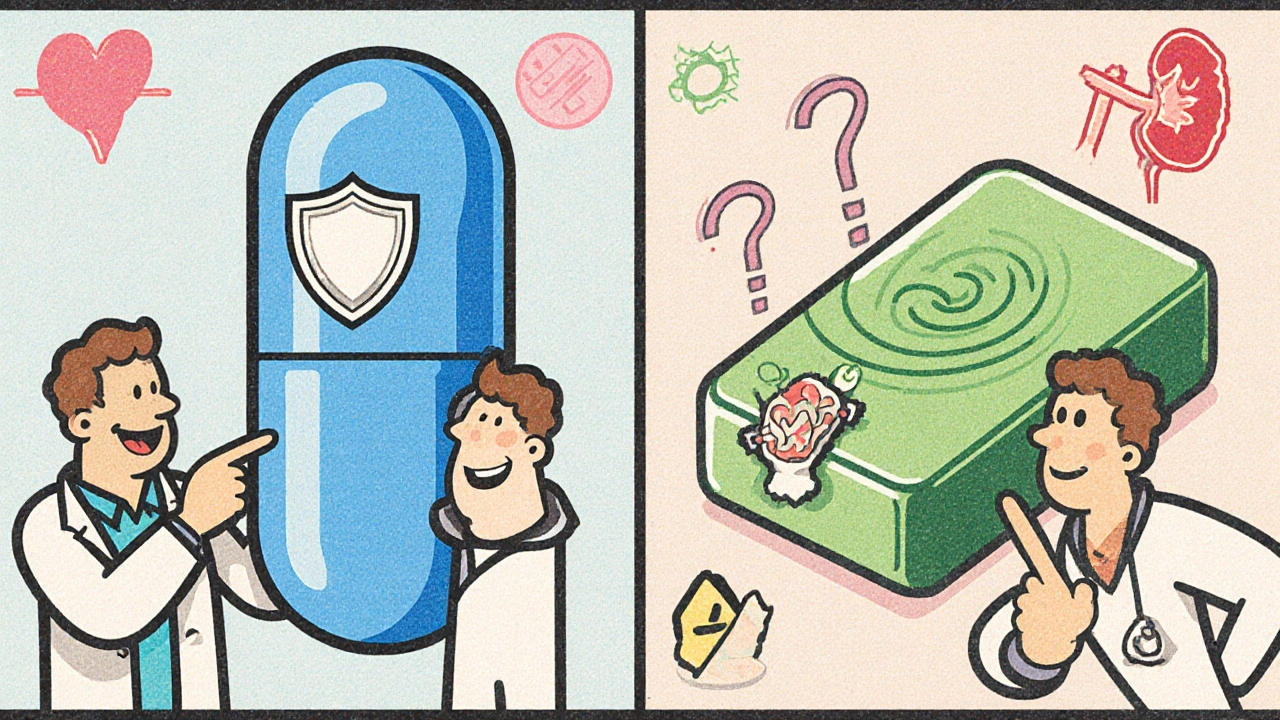Eplerenone Potassium Risk Calculator
Eplerenone Potassium Risk Assessment
This tool estimates your potassium risk when taking eplerenone based on current levels and medication combinations.
Risk Assessment
When discussing blood‑pressure drugs, Eplerenone is a selective mineralocorticoid receptor antagonist used to treat hypertension and heart failure. Understanding its eplerenone mechanism helps clinicians decide when it’s the right choice and explains why patients often notice fewer hormonal side effects than with older blockers.
What is Eplerenone?
Eplerenone belongs to the class of drugs called mineralocorticoid receptor (MR) antagonists. Unlike the first‑generation agent spironolactone, it was engineered to bind the MR with high specificity, sparing androgen and progesterone receptors. The result is a cleaner side‑effect profile, especially less unwanted gynecomastia in men.
Mineralocorticoid Receptor - The Target
The mineralocorticoid receptor is a nuclear hormone receptor that, when activated by the hormone aldosterone, drives sodium reabsorption and potassium excretion in the distal nephron. Overactivation contributes to fluid retention, elevated blood pressure, and cardiac remodeling. A concise definition follows:
Mineralocorticoid receptor is a receptor protein that mediates aldosterone’s effects on electrolyte balance and cardiovascular remodeling.
Step‑by‑Step: How Eplerenone Blocks Aldosterone
- Competitive Binding: Eplerenone enters the cytoplasm of renal tubular cells and competes with aldosterone for the ligand‑binding pocket of the MR. Its affinity (Kd ≈ 5 nM) is slightly lower than spironolactone but high enough to out‑compete physiological aldosterone levels (≈ 100‑200 pM).
- Receptor Conformation: Upon binding, eplerenone forces the MR into an inactive conformation that prevents co‑activator recruitment. This blocks transcription of genes such as ENaC (epithelial sodium channel) and Na⁺/K⁺‑ATPase.
- Reduced Sodium Reabsorption: With ENaC expression down‑regulated, less sodium is pulled back into the bloodstream, leading to modest natriuresis (average 25‑30 mmol/day).
- Potassium Retention: Since fewer sodium ions are exchanged for potassium, serum potassium rises modestly (≈ 0.3‑0.5 mmol/L). This is why clinicians monitor K⁺ levels, especially when combined with ACE inhibitors.
- Cardiac Impact: In the heart, MR blockade reduces fibroblast activation, limiting collagen deposition and preventing pathological left‑ventricular hypertrophy. Clinical trials show a 15‑20 % reduction in cardiovascular death for patients with reduced ejection fraction when eplerenone is added to standard therapy.
Pharmacokinetic Highlights
- Absorption: Oral bioavailability is ~70 %; peak plasma concentrations appear 1.5-3 hours after dosing.
- Distribution: Volume of distribution ≈ 0.5 L/kg; 50 % bound to plasma proteins, mainly albumin.
- Metabolism: Primarily via CYP3A4 to inactive metabolites. Strong CYP3A4 inhibitors (e.g., ketoconazole) can raise eplerenone AUC by up to 70 %.
- Elimination: Half‑life ≈ 4‑6 hours; renal excretion accounts for ~50 % of the dose, the rest eliminated in feces.

Clinical Uses and Dosing
Guidelines recommend eplerenone for two main indications:
- Hypertension: Starting dose 25 mg once daily; titrate to 50 mg based on blood‑pressure response and serum potassium.
- Post‑myocardial infarction heart failure: Initiate at 25 mg daily, aiming for 50 mg twice daily in patients with an ejection fraction ≤ 40 %.
Both scenarios require baseline labs (creatinine, potassium) and follow‑up checks at 1‑week and 1‑month intervals.
Comparison: Eplerenone vs. Spironolactone
| Attribute | Eplerenone | Spironolactone |
|---|---|---|
| Selectivity | Highly selective for MR | Non‑selective (binds androgen & progesterone receptors) |
| Risk of Gynecomastia | ≈ 0.5 % (rare) | 2‑10 % (dose‑dependent) |
| Potassium Rise | Modest (0.3‑0.5 mmol/L) | Similar or slightly higher |
| Half‑life | 4‑6 hours | 1.4‑2 hours (active metabolites last longer) |
| Drug Interactions | CYP3A4 inhibitors raise levels | Fewer CYP interactions, but strong inhibitors affect both |
For patients who can’t tolerate spironolactone’s hormonal side effects, eplerenone is the preferred choice, provided renal function is adequate.
Adverse Effects and Safety Tips
The most clinically relevant risk is hyperkalemia. Strategies to mitigate:
- Check baseline potassium (<5.0 mmol/L) and eGFR (>30 mL/min/1.73 m²).
- Avoid concurrent high‑dose potassium supplements or salt‑substitutes containing potassium.
- When combined with ACE inhibitors or ARBs, consider starting at 25 mg daily.
- Educate patients to report muscle weakness, palpitations, or unusual fatigue.
Other side effects include dizziness, headache, and rarely, cough. Because eplerenone does not block androgen receptors, breast tenderness and menstrual irregularities are uncommon.

Special Populations
- Elderly: Reduced renal clearance may necessitate lower starting doses.
- Pregnancy & Lactation: Classified as B‑3 (animal studies show risk); generally avoided unless benefits outweigh risks.
- Patients with Liver Disease: Since CYP3A4 metabolism occurs in the liver, severe hepatic impairment can increase exposure; monitor closely.
Key Takeaways
- Eplerenone selectively blocks the mineralocorticoid receptor, curbing aldosterone‑driven sodium retention and cardiac remodeling.
- Its high specificity translates to fewer hormonal side effects compared with spironolactone.
- Monitoring serum potassium and renal function is essential, especially when combined with other RAAS inhibitors.
- Clinical evidence supports mortality reduction in post‑MI heart‑failure patients when added to guideline‑directed therapy.
- Drug interactions are mainly via CYP3A4; avoid strong inhibitors unless dose‑adjusted.
Frequently Asked Questions
How quickly does eplerenone start working?
Blood‑pressure effects can be seen within 1‑2 weeks, but full cardiac remodeling benefits may take 3‑6 months of consistent therapy.
Can eplerenone be taken with a potassium‑rich diet?
A modest intake is usually fine, but high‑potassium supplements or salt substitutes should be avoided unless potassium levels are closely monitored.
Is eplerenone safe for patients on dialysis?
Because ~50 % is renally excreted, dose reduction (e.g., 25 mg every other day) is recommended, and hyperkalemia risk remains high.
What should I do if I miss a dose?
Take the missed tablet as soon as you remember unless it’s almost time for the next dose. Then skip the missed one and continue with the regular schedule-don’t double up.
How does eplerenone differ from other blood‑pressure drugs?
Unlike ACE inhibitors or ARBs that block earlier steps in the RAAS cascade, eplerenone acts at the final hormone‑receptor step, directly preventing aldosterone’s actions on the kidney and heart.
By grasping how eplerenone hijacks the mineralocorticoid receptor, clinicians can tailor therapy, avoid pitfalls, and leverage its proven mortality benefit for patients with heart failure or resistant hypertension.






ashanti barrett
October 19, 2025 AT 20:54When you sit down with a patient who’s scared of hormonal side effects, pointing out that eplerenone spares androgen receptors can instantly ease anxiety. It’s a drug that actually respects the body’s own signaling balance, so you often see better adherence. The modest potassium rise is something we can manage with routine labs, not a death sentence. Keep an eye on renal function, especially in older adults, and the therapy usually flies under the radar of unwanted gynecomastia. So, in short, this blocker gives you the pressure‑lowering punch without the drama of older agents.
Latasha Becker
October 25, 2025 AT 04:40In contrast to the generic description, the pharmacodynamic profile of eplerenone warrants precise terminology. Its competitive inhibition constant (Ki) approximates 5–10 nM, which denotes high‑affinity binding to the MR ligand‑binding domain. Moreover, the downstream attenuation of ENaC transcription translates into a quantifiable natriuretic output of roughly 25‑30 mmol per day, a figure corroborated by phase‑III data. The drug’s selective steric hindrance precludes cross‑reactivity with androgenic receptors, thereby mitigating gynaecomastia incidence below 1 %. Finally, CYP3A4‑mediated metabolism necessitates vigilant review of concomitant inhibitors to avoid supratherapeutic AUC elevations.
Madhav Dasari
October 30, 2025 AT 11:26Hey folks, let me break this down with a little drama (because science can be exciting!). Imagine the mineralocorticoid receptor as a stubborn lock, and eplerenone as the master key that slides right in and refuses to let aldosterone jam the door open. Once it’s in, the heart stops remodeling like a bad plot twist, and the kidneys chill out, letting sodium go on a vacation. The best part? You don’t have to worry about weird side‑effects like a broken heart from hormone mishaps. Just keep an eye on potassium, sip your meds with food, and you’ll be back to feeling like a champion. Stay positive, stay monitored, and let the drug do the heavy lifting!
DHARMENDER BHATHAVAR
November 4, 2025 AT 19:13Eplerenone demonstrates a half‑life of approximately five hours, enabling twice‑daily dosing in heart‑failure protocols. Its oral bioavailability sits near seventy percent, achieving peak plasma levels within three hours post‑administration. Renal excretion accounts for half of the dose, while hepatic metabolism via CYP3A4 handles the remainder. Adjustments are required in patients with moderate renal impairment to mitigate hyperkalaemia risk.
Kevin Sheehan
November 10, 2025 AT 03:00From a philosophical standpoint, the elegance of eplerenone lies in its terminal blockade of the RAAS cascade, embodying the principle of minimal interference. By targeting the receptor directly, we sidestep upstream complexities and achieve a cleaner therapeutic profile. Yet, the aggressor in clinical practice remains hyperkalaemia, demanding our vigilant oversight. Ultimately, the drug’s virtue is its specificity, reflecting a harmony between efficacy and safety.
Jay Kay
November 15, 2025 AT 10:46This drug is pretty much the gold standard for people who can’t stand the side effects of spironolactone. It blocks the bad stuff without messing with hormones, so you don’t get weird breast growth. The potassium rise is real but manageable with a simple blood test. If you have kidney issues, just start low and watch the labs. Overall, eplerenone is a solid, drama‑free option.
Jameson The Owl
November 20, 2025 AT 18:33Eplerenone's mechanism is not just a simple antagonism but a sophisticated allosteric modulation that finely tunes the receptor's conformational dynamics. By occupying the ligand‑binding pocket it imposes a steric constraint that precludes co‑activator recruitment, thereby halting downstream transcriptional cascades essential for sodium reabsorption. This nuanced interaction translates into a measurable natriuretic effect, typically quantified as a 25‑30 mmol per day increase, which, while modest, contributes to cumulative blood pressure reduction over weeks. Moreover, the drug's pharmacokinetic profile-characterized by a 70% oral bioavailability and a half‑life of four to six hours-facilitates steady‑state concentrations when dosed twice daily, ensuring consistent MR blockade. The hepatic metabolism via CYP3A4, however, introduces a layer of complexity; concomitant use of potent inhibitors like ketoconazole can elevate the area under the curve by up to seventy percent, necessitating dose adjustments. Renal excretion accounts for roughly half of the eliminated dose, making renal function a pivotal consideration in dosing strategies, especially in the elderly. Hyperkalaemia remains the chief adverse event, a risk amplified when eplerenone is combined with ACE inhibitors or ARBs, yet this can be mitigated through vigilant laboratory monitoring and dietary counseling. In contrast to spironolactone, eplerenone's selectivity markedly reduces off‑target effects on androgen and progesterone receptors, thereby virtually eliminating the incidence of gynecomastia-a benefit that improves patient compliance and quality of life. Clinical trial data underscore its mortality benefit, revealing a fifteen‑to‑twenty percent reduction in cardiovascular death among post‑myocardial infarction patients with reduced ejection fraction when added to standard therapy. This outcome is likely mediated by its anti‑fibrotic properties, where MR blockade curtails fibroblast activation and collagen deposition, preserving myocardial architecture. The drug's limited interaction profile-aside from CYP3A4 substrates-offers a cleaner therapeutic regimen, though clinicians must remain vigilant for potential drug‑drug interactions. Ultimately, eplerenone exemplifies a targeted approach that aligns molecular specificity with clinical efficacy, embodying the next generation of mineralocorticoid receptor antagonists.
Rakhi Kasana
November 26, 2025 AT 02:20While the exhaustive description above is impressive, it’s worth remembering that real‑world patients often struggle with medication adherence. The lengthy pharmacologic jargon can obscure simple advice: monitor potassium, stay hydrated, and report any unusual muscle weakness. If you’re on a potassium‑rich diet, consider a modest reduction rather than an abrupt stop. The drug’s benefits are undeniable, but clinicians should balance complexity with clear, actionable guidance.
Sarah Unrath
December 1, 2025 AT 10:06eplerenone is ok its 70% bio for factor and its u sure to watch potassium levels dont overdo it its work but need labs watch and keep track of kidney function.
James Dean
December 6, 2025 AT 17:53Good drug for hypertension.